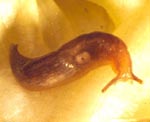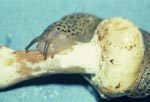Slugs
Nudibranchs

Figure 1. Gray Garden Slug
Description
Slugs are mollusks, related to oysters and
clams. Slugs are referred to a "naked snails," as they possess no shell.
Slugs lay clusters of translucent, pearly-shaped eggs under debris or
buried beneath the soil surface. They can lay between 20 to 100 eggs
several times per year, taking approximately two years for slugs to
reach maturity. The gray garden slug, Peroceras reticulatum, is
the slug generally encountered in Illinois. It is approximately 3/4 to
1-1/2 inches long, ranging in color from pale yellow, lavender, to
purple. In addition, they are covered with black or brown spots and
mottling. Less commonly encountered is the great gray garden slug, Limax maximus. It is up to 7 inches long and is yellow-gray to brown with black mottling.

Figure 2. Spotted Garden
Slug Damage
Slug activity is highly dependent on soil moisture, requiring moisture to move around. They secrete a slimy mucus substance, which they use to move about. This then dries up into a shiny noticeable trail. Slugs are active at night (nocturnal) when humidity is high from evening rains or irrigation. They hide during the day under mulch, plant debris, rocks, boards, weeds, and ground covers.
Wet weather generally favors an increase in slug populations. Slugs are destructive pests feeding on many plants in landscapes, gardens, and greenhouses including annuals, perennials, bulbs, ground covers, trees, and shrubs. In addition, slugs can devour young seedlings overnight. One of their favorite food plants is hosta. Slugs have rasping-chewing mouthparts and cause plant damage by creating large irregular shaped holes in leaves. They prefer to feed on succulent foliage such as seedlings, herbaceous plants, and fruit lying on the ground. Slugs have a strong sense of smell; they will travel substantial distances to locate a food source.
Management
Slug management involves a combination of
strategies such as hand picking, habitat modification, barriers, traps,
baits, and commercial molluscicides. Monitoring is important to
determine the effectiveness of slug management strategies. Monitoring
involves going out in the evening with a flashlight and looking for the
presence of slugs. During this time, handpicking can be performed to
reduce slug populations. Handpicking is especially effective during
moist weather conditions. Placing slugs into a jar with soapy water will
kill them. For heavy slug infestations another possibility is to employ
some neighborhood children to collect slugs and kill them. Various
beetles such as firefly larvae and ground beetles feed on slugs. In
addition, toads, frogs, snakes, and lizards eat slugs. However, these
predators may not be present in high enough numbers to keep slug
populations below damaging levels.
Habitat Modification
Habitat modification is one of the
most effective strategies in reducing slug populations. This involves
eliminating hiding places such as mulches, weeds, old vegetation, and
debris. Planting a diversity of trees and shrubs, especially those not
preferred by slugs such as rhododendron and hard-leafed evergreens, can
reduce slug populations and minimize plant damage. Cultivating the soil
around plants may reduce slug populations by destroying eggs. Proper
watering practices can also keep slug numbers low. Avoid watering late
in the day as this creates moist conditions conducive to slug activity.
Instead, water plants early in the morning. Research has demonstrated
that morning watering provides protection from slug injury comparable to
some slug baits. In addition, the use of drip irrigation systems where
water is directed toward individual plants may lead to fewer slugs.
Spacing plants far enough apart to allow air movement to dry the soil is
also helpful.
Barriers and Traps
Copper barriers can be placed around
the base of shrubs, flowerbeds, and trees that are being fed upon. They
can also be placed around flowerpots. Slugs receive a slight electric
shock when their moist bodies contact the copper; repelling them.
However, widespread use of this method may not be feasible. In addition,
copper bands have sharp edges, which can harm children and pets.
Diatomaceous earth, shredded bark, eggshells, lime, and wood ash have
been used as barriers to prevent slugs from feeding on plants. However,
these materials generally work best during dry periods when slugs are
less active. In addition, the effectiveness of these materials is
reduced by rainfall, which means they have to be reapplied regularly
after becoming wet. The use of some of these materials such as egg
shells, lime, and wood ash is discouraged because over time, they may
raise the pH of the soil. Also, never pour salt on slugs as this may
burn plant foliage and roots. Traps, such as wooden boards, rolled-up
newspapers, grapefruit rinds, and inverted one-gallon plant containers
can be placed where slugs are feeding. Check traps daily, early in the
morning. Place slugs into a jar with soapy water to kill them.
Baits
Baits are available that attract slugs into traps
where they then drown. Beer is one popular bait. Some die-hard
practitioners swear that beer reduces slug populations. Beer is poured
into a shallow pan, which is sunk into the ground with the pan edges
sticking up 1/8 to 1/4 inch. Slugs are attracted to the yeasty smell of
beer and they fall into the pan and drown. Aldehydes in the beer may
also be toxic to the slugs. Studies from Colorado State University have
shown that Kingsbury Malt Beverage (from Heileman Breweries) is the beer
most preferred by slugs. However, beer does not have an EPA
registration number, so the use of beer as a pesticide is not
technically legal.
Slug baits that are commercially available are
applied to areas that need protection. However, some baits may be toxic
to non-target organisms such as dogs, birds, and earthworms. Some baits
should not be applied around food crops. Check the label on the bait.
Baits are less effective during hot, dry times of the year when slugs
are less active. Irrigate before applying these materials to promote
slug activity. Make spot applications as opposed to broad scale
applications.
Prepared by Raymond A. Cloyd and Philip L. Nixon, Department of Natural Resources and Environmental Sciences, University of Illinois, Urbana, Illinois, in cooperation with the Illinois Natural History Survey. For additional copies, contact your local University of Illinois Extension Office.